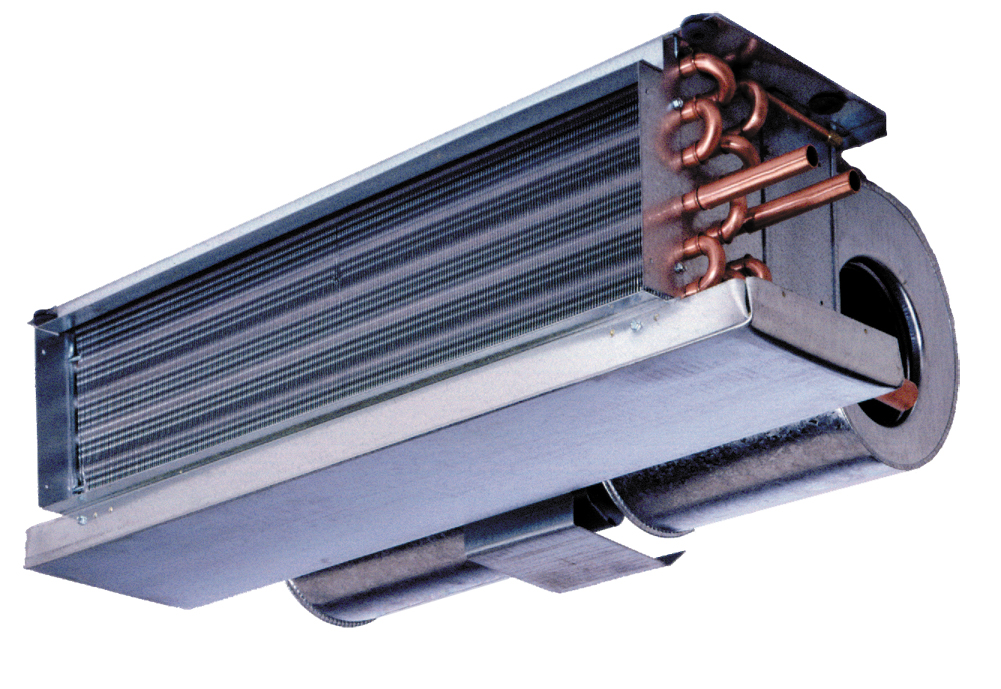
Many fan coil unit installations are in condos, apartments, townhouses, hotels, and other types of lodging. Most systems are two or four pipe heating/cooling systems and usually use chilled water for cooling and hot water for heating. These units can be permanent or temporary residences occupied by an owner, tenant, or paying customer, which may mean they are more demanding.
There are 3 types of units normally used for residence-type installations, and they are as follows:
- Vertical cabinet fan coil units – either against the wall or furred into the wall. These units are not ducted and normally heat and cool one room. As much as 25% of fresh air can be introduced through the wall in the back of the unit.

- Horizontal ceiling mounted units – ducted at least on the supply side and many times on the return side. A basic unit can have the filters installed in a return grate in the ceiling, while the plenum above the ceiling is used as the return into the unit. There are also return plenum style units that have a ducted return and filter as an integral part of the unit.

- Vertical closet style unit – normally installed in a utility closet and many times are located next to an outdoor deck. These units have a grilled return, a vertical ducted supply, and include filters.

Here is a list of common problems that owners and HVAC service people experience with these 3 types of units:
Cooling Performance Problems
Chilled water-cooling systems for these installations must distribute the volume and temperature of water from a chiller for long distances and often upwards through many floors. Most fan coil units have either 3 or 4 row chilled water coils and have very little ability to overcome deficiencies based on undersized chilled water loops. Often, the chilled water is delivered at a higher temperature or lower volume. This can cause a reduction of 20 – 30% less BTUH exchange. A unit that is supposed to deliver air to a space at 57 degrees might be delivering air at 62 degrees, which falls considerably short of cooling the space.
The existing unit most likely won’t be able to overcome the chilled water deficiencies, and the fan coil units will need to be replaced. Once everyone understands the gravity of the problem, a new unit will be selected to overcome the deficiencies. This may include more rows of cooling, different coil circuitry, and possibly a more powerful fan.
Air Flow Problems
Fan coil units have squirrel cage fans and have limited ability to deal with added air resistance. Sometimes the design of air flow versus resistance is much lower than the actual resistance found on many installations. There are also systems that have dirty plenums, filters, and coils that increase the resistance. An increase in resistance lowers the air volume (CFM) and can cause a space to improperly cool or heat. There can also be problems with air distribution. The air flow may be as designed, but the duct system and delivery to the space may not be adequate to achieve cooling or heating.
New units need to be designed for the external pressure resistance that exists so that the air flow meets the requirements of the space. These new units will usually be equipped with higher volume fans that will overcome the resistance. When there is a distribution problem, a new unit will allow for extra ductwork and grilles that may be required to deliver the air properly.
Sound Problems
The cooling and heating of a residence will require units and entire systems that operate quietly. People hear things differently, what’s quiet to one person may be noisy to another. Since these units will be operating either in the actual space or directly above the space, they will need to be as quiet as possible. Many installations do not take this into consideration and owners or tenants will constantly be hounding maintenance and HVAC service people to eliminate unwanted noise.
Once again, new units will be needed, because the volume of air required must be met at lower speeds. Most fan coil units have 3 speeds, and 95% of all installations are designed at high speed. To assist in fixing a noise problem, the fan must be designed at a lower speed but with more cooling rows to meet the capacity.
You can replace your existing open or plenum unit with a fully insulated cabinet style unit. However, this choice is only viable if it can fit into the existing unitary space. We can also specify return air and/or supply duct sound attenuators that will further reduce air noise. But, remember: any item placed in the ductwork adds resistance, and the fan coil unit fan must be sized to overcome this extra resistance to allow for the proper air flow into the space.
Many residence installations have inherent problems that can be reduced or eradicated with a quality engineering review. Based on that review, the proper selection of new fan coil units can be made. The good news, you won’t have to deal with lowered cooling or heating, reduced air flow, or sound problems.
